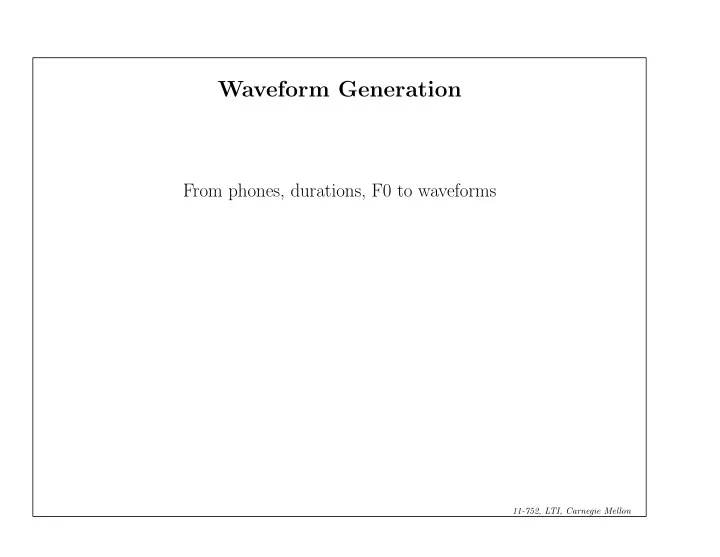

Waveform Generation From phones, durations, F0 to waveforms 11-752, LTI, Carnegie Mellon
Types of synthesis ✷ Articulartory: model the human vocal tract ✷ Formant: model the voice signal ✷ Concatenative: diphones, unit selection ✷ Statistical Parametric Synthesis ✷ Canned speech 11-752, LTI, Carnegie Mellon
Waveform generation ✷ Formant synthesis ✷ Random word/phrase concatenation ✷ Phone concatenation ✷ Diphone concatenation ✷ Sub-word unit selection ✷ Cluster based unit selection ✷ Clustergen SPS synthesis 11-752, LTI, Carnegie Mellon
Concatenative synthesis ✷ Select appropriate speech unit ✷ Impose desired prosody ✷ Reconstruct signal from modifed parts Quality is usually good, but less flexible than formant or articulatory. 11-752, LTI, Carnegie Mellon
Diphone synthesis ✷ mid-phone is more stable than edge ✷ Need phone 2 number of units: – some combinations don’t exist (hopefully) – may include stress, consonant clusters – lots of phonetic knowledge in design ✷ Database relatively small (by today’s standards) – around 8 meg for English (16KHz 16bit) 11-752, LTI, Carnegie Mellon
Designing a diphone inventory Nonsense words ✷ Build set of carrier words: – pau t aa b aa b aa pau – pau t aa m aa m aa pau – pau t aa m iy m aa pau – pau t aa m ih m aa pau ✷ Advantages: – easy to get all diphones – will be pronounced consistently – (no lexical interferance) ✷ Disadvantages: – (possibly) bigger db – will be pronounced consistently – (speaker becomes bored) As we will be randomly joining these units consistency is probably key 11-752, LTI, Carnegie Mellon
Designing a diphone inventory Natural words ✷ Greedily select sentences/words: – quebecois arguments (19) – brouhaha abstractions (18) – arkansas arranging (11) ✷ Advantages: – will be pronounced naturally – easier for speaker to pronounce – smaller db ? (505 pairs vs 1345 words) ✷ Disadvantages: – will be pronounced naturally – may not be pronounced correctly Diphone distribution in natural text is very variable 11-752, LTI, Carnegie Mellon
Making recordings consistent Natural words ✷ Diphone should come from mid-word – help ensure full articulation ✷ Performed consistently – constant pitch, power, duration ✷ Use (synthesized) prompts: – help avoid pronunciation problems – keep speaker consistent – used for alignment in labelling 11-752, LTI, Carnegie Mellon
Building diphone schema ✷ Find list of phones in language: – plus interesting allophones – stress, tones, clusters, onset/coda etc – foreign (rare) phones, ✷ Build carriers for: – consonant-vowel, vowel-consonant, – vowel-vowel, consonant-consonant, – silence-phone, phone-silence, – other special cases ✷ Check the output: – list all diphones and justify missing ones – every diphone list has mistakes 11-752, LTI, Carnegie Mellon
Recording conditions ✷ Ideal: – anechoic chamber – studio quality recording – EGG signal ✷ What we put up with: – quiet room – cheap microphone/sound blaster – no EGG – headmounted microphone ✷ What we can do – repeatable conditions – careful setting on audio levels 11-752, LTI, Carnegie Mellon
Labelling Diphones ✷ Much easier than phonetic labelling: – the phone sequence is defined – they are clearly articulated – if its wrong, its wrong ✷ Phone boundaries less important – +/- 10ms is okay. ✷ Midphone boundaries important – where is the stable part – can it be automatically found 11-752, LTI, Carnegie Mellon
Dynamic Time Warping Find shortest euclidean distance through table 11-752, LTI, Carnegie Mellon
Simple autoalignment Much easier than full autolabelling ✷ Synthesizer phone string ✷ Time align prompt to spoken form – using euclidean distance ✷ Works very well 95%+ – errors are typically large (easy to fix) – maybe even automatically detected ✷ This works cross-language too: – even when phones don’t exist – e.g. English prompts with Korean spoken form Malfrere and Dutoit 97 11-752, LTI, Carnegie Mellon
Diphone alignment Does it work? ✷ DP align MFCC prompt to spoken word ✷ test against hand labelled type RMSE stddev KED-KED self 14.77ms 17.08 MWM-KED US-US 27.23ms 28.95 GSW-KED UK-US 25.25ms 23.92 KED-WHY US-Kor 28.34ms 27.52 11-752, LTI, Carnegie Mellon
Stable part in phones ✷ Middle of phone: – one third in for stops – one quarter in for phone-silence – half way for rest ✷ In time alignment case: – Add explicit diphone boundaries – (only need to hand correct once) ✷ Optimal coupling (Conkie and Isard 96) – automatically find them – using Euclidean distance of cepstrum – find minimum join point over all phone-phone – or find best for each phone-phone ✷ Hand check each one: – what “real” companies do 11-752, LTI, Carnegie Mellon
Diphone boundaries in stops 11-752, LTI, Carnegie Mellon
Diphone boundaries at end phones 11-752, LTI, Carnegie Mellon
Autolabelling vs Hand labelling Recorded KAL (US male) ✷ around 15-20 examples wrong (KED-KAL) ✷ As good as first pass by human labellers ✷ 45 mins vs 2 weeks hand labelling ✷ Whole voice in under 2 days ◦ recording 3-4 hours ◦ pitch mark extraction 3 hours ◦ alignment 1 hour ◦ hand correction and tuning (3 hours) 11-752, LTI, Carnegie Mellon
Recommend
More recommend